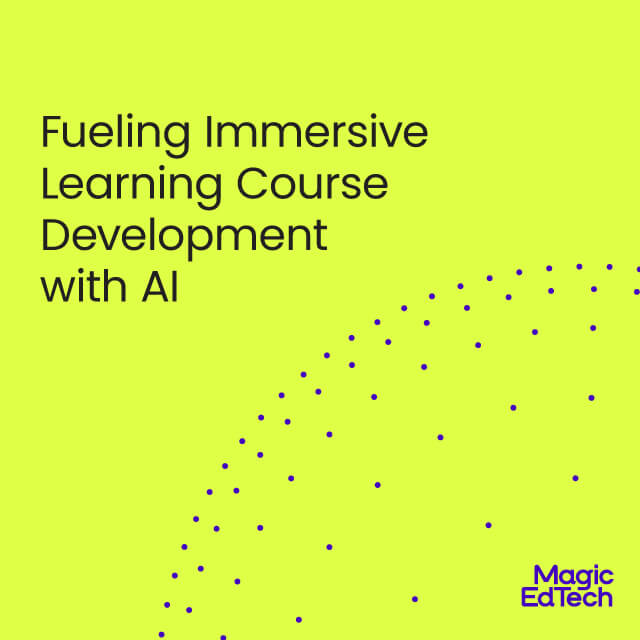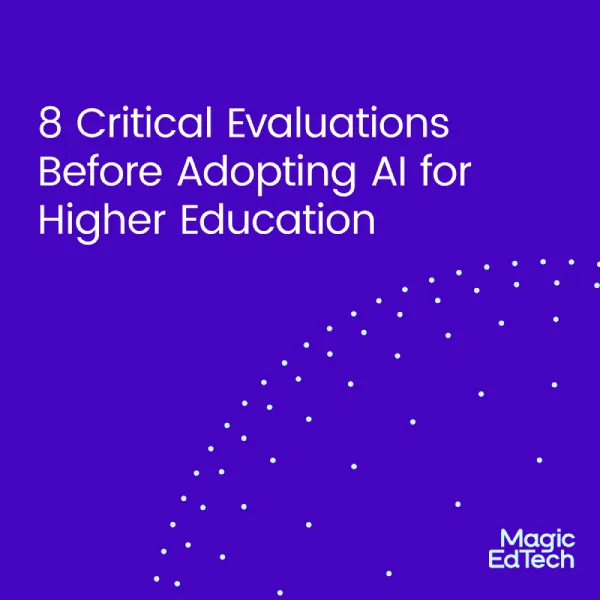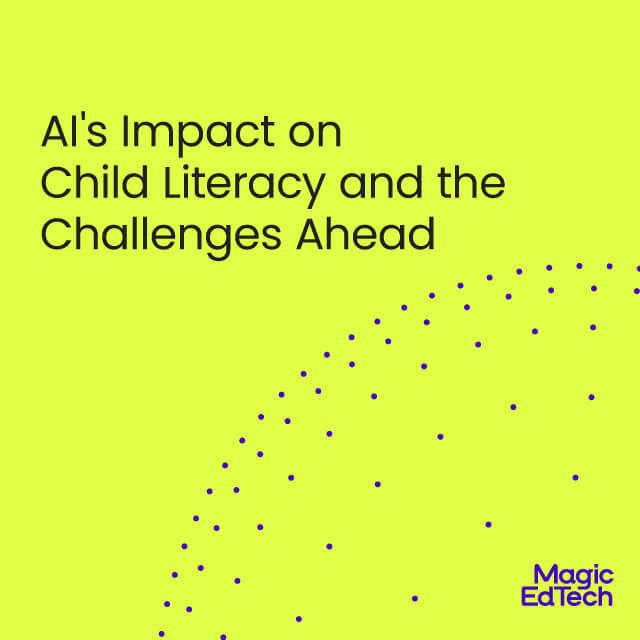Enhancing eLearning Software Development Solutions with AI Across the SDLC
- 4 August, 2023
- Reading Time: 7 mins
“Success in creating AI would be the biggest event in human history. Unfortunately, it might also be the last unless we learn how to avoid the risks.”
-Stephen Hawking, Theoretical Physicist
Organizations are constantly looking for ways to ensure that their software development process is as lean, effective, and high-performing as it can be. As technology evolves, so do the tools available to developers and tech leaders, making it a never-ending quest for optimization.
Among all the innovations, Artificial Intelligence (AI) has emerged at the forefront of change. There is both optimism and skepticism about its implementation. eLearning software development is no different; and in this article, we explore how integrating AI across the e-Learning Software Development Life Cycle (SDLC) stages can change productivity, software quality, and the lifecycle of eLearning development.

Where Can AI Safely Sit Across the SDLC?
Artificial Intelligence (AI) offers several advantages throughout eLearning solutions‘ Software Development Life Cycle (SDLC). From initial planning to maintenance, AI technologies can enhance various stages of development. Let’s explore the benefits across each phase:
Planning Phase:
- Data-driven insights: AI can analyze historical eLearning data, identify learners’ preferences, and suggest suitable courses, content, and delivery methods.
- Market analysis: AI-powered tools can study the eLearning market, identifying trends, popular topics, and potential competitors, helping define a successful product strategy.
Design Phase:
- Personalization: AI can customize the learning experience by adapting content and difficulty levels based on individual learners’ capabilities and progress.
- Content creation: AI can generate content for eLearning materials, including automated text generation, interactive exercises, and even basic quizzes.
Development Phase:
- Automated testing: AI can expedite testing processes by automating test case generation and execution, reducing the chances of undetected bugs.
- Natural Language Processing (NLP): NLP-powered AI can enable chatbots and virtual assistants, facilitating learner engagement and providing instant support.
Implementation Phase:
- Learning analytics: AI can analyze learner interactions and performance to provide real-time feedback to educators and optimize the learning process.
- Predictive analytics: AI algorithms can forecast learner behavior, dropout, and course completion rates, allowing early intervention strategies./li>
Deployment Phase:
- Recommendation systems: AI can suggest supplementary courses or materials based on the learners’ preferences and past activities, encouraging continued engagement.
- Automated grading: AI can assist in grading objective assessments, freeing up instructors’ time for more personalized feedback and interactions.
Maintenance Phase:
- Content updating: AI can identify outdated content and recommend updates, ensuring that eLearning materials remain relevant and accurate.
- Bug detection and troubleshooting: AI can continuously monitor the system for anomalies and errors, aiding in proactive maintenance.
Continuous Improvement Phase
- Adaptive learning: AI can refine and adapt the eLearning content and structure based on continuous feedback and learner performance.
- Sentiment analysis: AI can analyze learner feedback and sentiment to gauge satisfaction levels and identify areas for improvement.
Incorporating AI into the SDLC of eLearning solutions can lead to enhanced user experiences, increased learner engagement, and more effective educational outcomes.
However, it’s essential to carefully consider ethical implications and data privacy concerns when using AI in eLearning environments.
How Software Teams Could Benefit from AI
Throughout the Software Development Life Cycle (SDLC), various teams collaborate to ensure the successful development and deployment of the eLearning solution.
The Product team takes on the initial planning stages, mapping out project concepts, and creating a structured Business Requirements Document (BRD) with user stories. With AI tools like GitMind AI and ChatGPT, they can streamline brainstorming sessions and idea organization, ensuring a more efficient and comprehensive planning process.
Moving to design, the UI/UX team crafts user-centric interfaces using wireframes and user personas. AI-powered design tools such as Vizard, Dall-E, Midjourney, and QoQo.ai add an innovative dimension to their work. By leveraging AI, they can generate creative design elements that cater to diverse user needs, elevating the overall user experience. For front-end development, the team can accelerate coding tasks with tools like Tabnine, and GitHub Copilot. These AI-driven aids expedite the coding process, allowing the team to focus on refining user interactions and ensuring the quality of front-end components through thorough unit testing.
The Back-end Development team benefits from AI integration as it enhances their ability to build complex server-side components and databases. This results in a more efficient development process and robust backend architecture, reinforced by AI-assisted unit testing. Quality assurance takes on a new level of efficiency with AI. The Automation Testing team creates automated test scenarios using AI tools. These AI-powered tests ensure comprehensive coverage and accurate results, working in tandem with the Manual Testing team to verify the integrity of the eLearning platform. Managing the technical infrastructure becomes smoother with the CloudOps team leveraging AI-powered tools. They set up CI/CD pipelines, handle cloud resources, and deploy the platform with Infrastructure as Code (IaaC). AI-driven tools assist in resource management and performance monitoring, enhancing overall efficiency and stability.
By leveraging AI at strategic points within the SDLC and their respective expertise, these teams can collaboratively contribute to a refined and innovative development process, ensuring the successful creation and deployment of high-quality eLearning solutions.

The Impact of AI on Productivity and Decision-Making
Integrating AI to improve how software is developed is like giving a turbo boost to the entire process. It’s not just about making things more efficient – it’s about making them better in many ways. With AI automating repetitive and time-consuming tasks, developers can focus on more innovative aspects of software development. The insights from AI-powered data analysis facilitate informed decision-making, which makes planning projects and deciding how to use resources easier.
AI can be especially powerful when it comes to generating new code. Incorporating AI for new code generation can result in a remarkable increase in productivity, with gains reaching up to approximately 40%. Moreover, AI isn’t limited to just creating new code. It proves its utility in supporting and enhancing existing software as well leading to productivity gains ranging from 10% to 15%.
AI doesn’t just make work easier; it also makes teams work together better. AI-powered tools provide real-time status updates and visualize task dependencies, fostering effective communication and coordination. Leveraging AI-driven insights fuels seamless communication and precision in team synchronization. By automating mundane tasks, developers can explore new ideas, experiment with new technologies, and refine user experiences, driving innovation within the team.
AI also facilitates cross-functional collaboration by breaking down silos and promoting knowledge sharing. This collaborative environment nurtures a culture of continuous learning and improvement, elevating team productivity and catching issues before they escalate into substantial challenges.
Automated Bug Detection and Automated Performance Testing are two crucial aspects that significantly improve eLearning solutions’ across a Software Development Life Cycle (SDLC). Let’s learn more about them with examples:
Automated Bug Detection
Automated bug detection involves using tools and scripts to identify and report software defects without manual intervention. This process saves time, ensures more comprehensive test coverage, and increases the overall quality of the eLearning solution.
For example, you add a new feature to an eLearning platform that allows users to upload and share documents with their peers. During manual testing, the testers may have limited time to test various file formats, resulting in some potential bugs remaining undetected.
With automated bug detection, a testing script can simulate various document uploads covering multiple formats and sizes. The script can then automatically validate the uploaded files, checking for errors in formatting, security vulnerabilities, and compatibility issues. If any bugs are found, they are immediately logged and can be addressed by the development team.
Automated Performance Testing
Automated performance testing involves evaluating how well the eLearning solution performs under different conditions, such as concurrent user loads and varying network speeds. It helps identify bottlenecks and performance issues early in the development cycle, allowing developers to optimize the system’s performance.
For example, an eLearning platform expects a surge in user activity during peak hours, like when students access the platform after school hours. Manual performance testing might not accurately simulate this high user load scenario, leading to performance problems during actual usage.
With automated performance testing, load testing scripts can be developed to simulate thousands of concurrent users accessing the platform simultaneously during peak hours. The hands can monitor server response times, database queries, and system resource utilization. If the platform’s response time exceeds predefined thresholds or the database becomes overloaded, the automated test will raise alerts, helping the development team proactively address the performance issues.
So, by integrating automated bug detection and automated performance testing into the eLearning solution’s SDLC, developers can identify and resolve potential issues early on, leading to a more robust and reliable platform.
It also enhances the user experience and ensures the eLearning solution functions smoothly even under heavy user loads. Automated testing allows for frequent testing iterations without incurring significant time and resource costs, accelerating the overall development process.
Final Thoughts
Implementing AI across the SDLC presents many advantages for organizations in the eLearning software development domain. From requirements gathering to maintenance, AI-driven solutions streamline processes, improve software quality, and enhance decision-making capabilities. Automated bug detection and performance testing tools further augment these benefits, ensuring robust and high-performing software products.
With AI’s potential improvements and efficiencies, organizations that integrate AI into their software development practices gain a significant competitive advantage. As the eLearning industry continues to grow and evolve, staying ahead of the curve is essential for success.
If you want to implement AI into e-Learning solutions seamlessly, let’s talk! Magic EdTech’s AI-infused solutions take your eLearning software development to the next level and propel your organization into a future of innovation and excellence. Click here to learn more about our offerings or schedule an appointment without experts to start your organization’s transformative journey.





